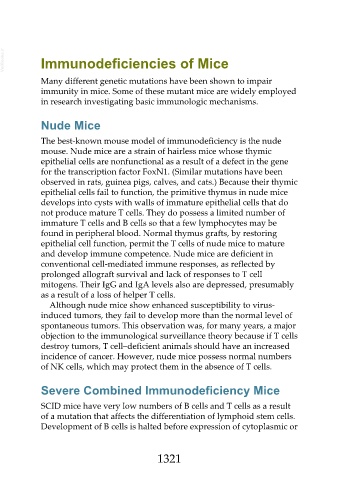Page 1321 - Veterinary Immunology, 10th Edition
P. 1321
VetBooks.ir Immunodeficiencies of Mice
Many different genetic mutations have been shown to impair
immunity in mice. Some of these mutant mice are widely employed
in research investigating basic immunologic mechanisms.
Nude Mice
The best-known mouse model of immunodeficiency is the nude
mouse. Nude mice are a strain of hairless mice whose thymic
epithelial cells are nonfunctional as a result of a defect in the gene
for the transcription factor FoxN1. (Similar mutations have been
observed in rats, guinea pigs, calves, and cats.) Because their thymic
epithelial cells fail to function, the primitive thymus in nude mice
develops into cysts with walls of immature epithelial cells that do
not produce mature T cells. They do possess a limited number of
immature T cells and B cells so that a few lymphocytes may be
found in peripheral blood. Normal thymus grafts, by restoring
epithelial cell function, permit the T cells of nude mice to mature
and develop immune competence. Nude mice are deficient in
conventional cell-mediated immune responses, as reflected by
prolonged allograft survival and lack of responses to T cell
mitogens. Their IgG and IgA levels also are depressed, presumably
as a result of a loss of helper T cells.
Although nude mice show enhanced susceptibility to virus-
induced tumors, they fail to develop more than the normal level of
spontaneous tumors. This observation was, for many years, a major
objection to the immunological surveillance theory because if T cells
destroy tumors, T cell–deficient animals should have an increased
incidence of cancer. However, nude mice possess normal numbers
of NK cells, which may protect them in the absence of T cells.
Severe Combined Immunodeficiency Mice
SCID mice have very low numbers of B cells and T cells as a result
of a mutation that affects the differentiation of lymphoid stem cells.
Development of B cells is halted before expression of cytoplasmic or
1321

